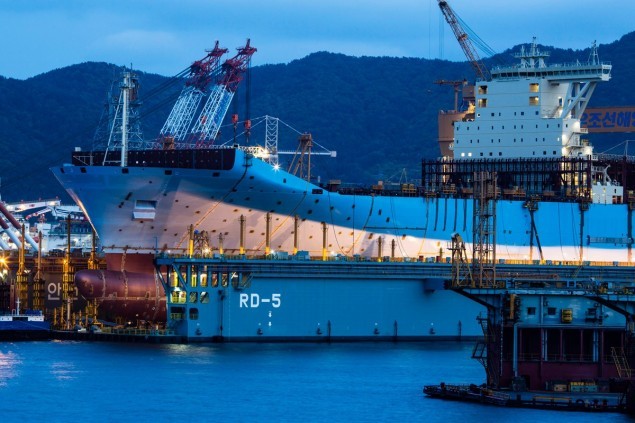Photo of a Maersk Triple-E class ship under construction at DSME shipyard, Geoje, South Korea. Photo by Thorbjorn Hansen, Maersk
By Clement Tan and Kyunghee Park
Sept. 18 (Bloomberg) — In shipping these days, bigger is better. Even if it’s just one meter.
China Shipping Container Lines Co. is ready to launch the largest container ship ever built, a 400-meter (1,300 feet) behemoth that stretches more than four football fields and can haul about 190 million iPads. The vessel promises to nose out the 399-meter A.P. Moeller-Maersk A/S Triple-Es to be the longest ship afloat, when it sets sail in November.
The ship — the first of five similar vessels on order — will give China bragging rights in a key industry as depressed container rates are driving lines to seek economies of scale and lower fuel costs. Introducing the fuel-efficient Triple Es last year helped Maersk Line, the biggest container-shipping company, boost profit 56 percent to $1 billion in the first half of the year.
China Shipping Container Lines’ new vessels will carry 19,100 standard 20-foot containers, the company said, or 830 more than its rival. They will use one-fifth less fuel than the common 10,000-box variety, according to Hyundai Heavy Industries Co. of South Korea, which is building the ships.
“The example of Maersk is quite clear,” said Lawrence Li, Shanghai-based shipping analyst at UOB Kay Hian Holdings Ltd. “If you want to make money now, your ships need to be fuel- efficient and you need to have economies of scale so that you can lower per-box cost or you need to provide a premium service.”
Record Length
China Shipping Container Lines will probably report a 43.6 million yuan ($7.1 million) net loss this year, based on the average of 16 analyst estimates compiled by Bloomberg. That would follow a 2.6 billion yuan loss in 2013. The company is projected to swing to a 493 million yuan profit next year, when its five new vessels are hauling goods.
The company dropped 1.3 percent today to HK$2.31 as of the close in Hong Kong trading, paring its gain this year to 14 percent in Hong Kong this year, outperforming the 3.7 percent gain by the benchmark Hang Seng Index.
The company’s new ships will be the longest now afloat, though several now-junked oil tankers were longer. The container ships will be 38 meters longer than Royal Caribbean Cruises Ltd.’s Oasis of the Seas and 67 meters longer than the U.S. Navy’s Nimitz-class aircraft carriers.
Slow Steaming
At 186,000 gross tons, the China Shipping Container Lines ships will displace less water than Vale SA’s 200,000-ton Valemax bulk freighters.
The new ships save fuel by traveling more slowly and using technology that adjusts the vessel’s speed to account for sea conditions. Maersk’s Triple Es are similarly 20 percent more efficient than its previous biggest ships, which could carry 15,500 boxes.
The move toward bigger, more fuel-efficient ships is also being driven by expanded alliances that allow lines to boost yields by sharing space on each other’s vessels. Lines with the largest capacity can command the most leverage in the groups.
Expanding Alliances
China Shipping Container Lines said Sept. 9 that it had signed agreements with CMA CGM, of France, and United Arab Shipping Co. to collaborate on four major routes.
Maersk and Mediterranean Shipping Co. — the world’s two biggest container-shipping lines — also agreed in July to share vessels. Chinese regulators had previously blocked a proposed three-way alliance that would have included CMA CGM, the world’s third-largest.
Orders for ultra-large vessels are also on the table for shipping companies that make up the G6 alliance, said Alan Tung, acting chief financial officer for Orient Overseas International Ltd., which is part of the group. The alliance also includes Hapag-Lloyd AG, Hyundai Merchant Marine Co., Neptune Orient Lines Ltd., Mitsui O.S.K. Lines Ltd. and Nippon Yusen KK.
Defending Margins
The era of big ships coincides with less sensitivity to fluctuations in rates, Park Moo Hyun, an analyst at Hana Daetoo Securities Co. in Seoul. Alliances, bigger ships and greater fuel efficiency are giving lines a way to defend margins when rates fall.
The Drewry Hong Kong-Los Angeles Container Rate — the cost to move one 40-foot container between to the two ports — peaked at $2,880 in August 2012. It hit a low of $1,650 on June 17 and recovered to $2,275 as of Sept. 9 on stronger demand for Asian goods.
“Maersk has shown the benefits of having vessels that are both fuel efficient and provide economy of scale,” Park said. “The shipping industry is no longer just about rates. It’s also about who can cut costs more effectively.”
Copyright 2014 Bloomberg.

 Join The Club
Join The Club











